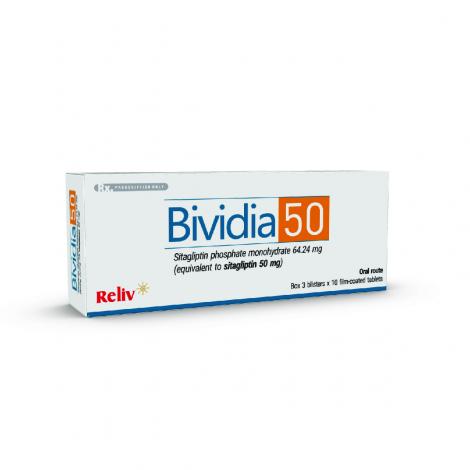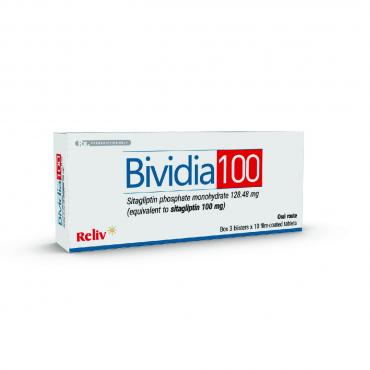The dose is 100 mg sitagliptin once daily. When used in combination with metformin and/or a PPARγ agonist, the dose of metformin and/or PPARγ agonist should be maintained, and sitagliptin administered concomitantly.
When sitagliptin is used in combination with a sulphonylurea or with insulin, a lower dose of the sulphonylurea or insulin may be considered to reduce the risk of hypoglycaemia.
If a dose of sitagliptin is missed, it should be taken as soon as the patient remembers. A double dose should not be taken on the same day.
Special populations
Renal impairment
When considering the use of sitagliptin in combination with another anti-diabetic medicinal product, its conditions for use in patients with renal impairment should be checked.
For patients with mild renal impairment (glomerular filtration rate [GFR] ≥ 50 mL/min), no dose adjustment is required.
For patients with moderate renal impairment (GFR ≥ 30 to < 50 mL/min), the dose of Sitagliptin is 50 mg once daily.
For patients with severe renal impairment (GFR <30 mL/min) or with end-stage renal disease (ESRD) (GFR < 15 mL/min), including those requiring haemodialysis or peritoneal dialysis, the dose of Sitagliptin is 25 mg once daily. Treatment may be administered without regard to the timing of dialysis.
Because there is a dosage adjustment based upon renal function, assessment of renal function is recommended prior to initiation of Sitagliptin and periodically thereafter.
Hepatic impairment
No dose adjustment is necessary for patients with mild to moderate hepatic impairment. Sitagliptin has not been studied in patients with severe hepatic impairment and care should be exercised.
However, because sitagliptin is primarily renally eliminated, severe hepatic impairment is not expected to affect the pharmacokinetics of sitagliptin.
Elderly
No dose adjustment is necessary based on age.
Paediatric population
Sitagliptin should not be used in children and adolescents 10 to 18 years of age because of insufficient efficacy. Sitagliptin has not been studied in paediatric patients under 10 years of age.
METHOD OF ADMINISTRATION
Sitagliptin can be taken with or without food.
Hypersensitivity to the active substance or to any of the excipients of this drug
General
Sitagliptin should not be used in patients with type 1 diabetes or for the treatment of diabetic ketoacidosis.
Acute pancreatitis
Use of DPP-4 inhibitors has been associated with a risk of developing acute pancreatitis. Patients should be informed of the characteristic symptom of acute pancreatitis: persistent, severe abdominal pain. Resolution of pancreatitis has been observed after discontinuation of sitagliptin (with or without supportive treatment), but very rare cases of necrotising or haemorrhagic pancreatitis and/or death have been reported. If pancreatitis is suspected, sitagliptin and other potentially suspect medicinal products should be discontinued; if acute pancreatitis is confirmed, sitagliptin should not be restarted. Caution should be exercised in patients with a history of pancreatitis.
Hypoglycaemia when used in combination with other anti-hyperglycaemic medicinal products
In clinical trials of sitagliptin as monotherapy and as part of combination therapy with medicinal products not known to cause hypoglycaemia (i.e. metformin and/or a PPARγ agonist), rates of hypoglycaemia reported with sitagliptin were similar to rates in patients taking placebo. Hypoglycaemia has been observed when sitagliptin was used in combination with insulin or a sulphonylurea. Therefore, to reduce the risk of hypoglycaemia, a lower dose of sulphonylurea or insulin may be considered.
Renal impairment
Sitagliptin is renally excreted. To achieve plasma concentrations of sitagliptin similar to those in patients with normal renal function, lower dosages are recommended in patients with GFR < 45 mL/min, as well as in ESRD patients requiring haemodialysis or peritoneal dialysis.
When considering the use of sitagliptin in combination with another anti-diabetic medicinal product, its conditions for use in patients with renal impairment should be checked.
Hypersensitivity reactions
Post-marketing reports of serious hypersensitivity reactions in patients treated with sitagliptin have been reported. These reactions include anaphylaxis, angioedema, and exfoliative skin conditions including Stevens-Johnson syndrome. Onset of these reactions occurred within the first 3 months after initiation of treatment, with some reports occurring after the first dose. If a hypersensitivity reaction is suspected, Sitagliptin should be discontinued. Other potential causes for the event should be assessed, and alternative treatment for diabetes initiated.
Bullous pemphigoid
There have been post-marketing reports of bullous pemphigoid in patients taking DPP-4 inhibitors including sitagliptin. If bullous pemphigoid is suspected, sitagliptin a should be discontinued.






